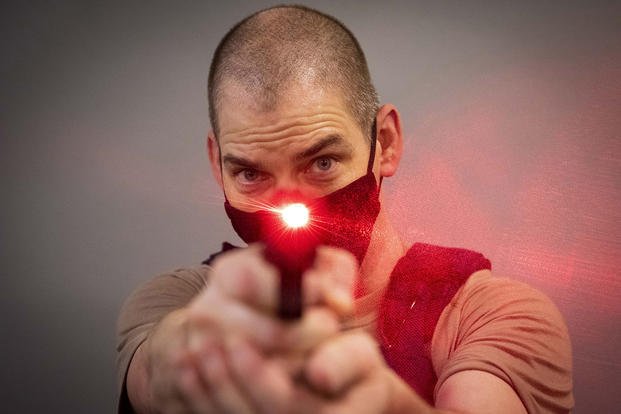The term tactical fitness is a fairly new concept. It's still being defined after a decade of varying programs that prepare candidates for challenging professions in military, Special Ops, police, SWAT and firefighting organizations. Though all of the jobs are different, they all demand one thing: fitness. In a tactical profession, fitness can be the difference between life and death.
Over the years, tactical fitness trainers, including myself, have focused on the types of training that help people acquire physically demanding jobs by passing basic entry-level fitness tests. After admission, the programming advances so people can graduate rigorous, high-attrition training programs.
Getting to and through training is a very important part of tactical fitness. However, those who make it to their chosen line of work must maintain their bodies and constantly grow their tactical skills, such as shooting. When it comes to a basic skill like handling a firearm, typical fitness programming falls short.
The law of specificity applies to more advanced real tactical skills like shooting, moving and fighting (people, guns, fire, etc.). I have found the following products to be unbelievably useful in building a stable fighting and shooting platform and working on sight alignment and trigger control.
The unique safety of these products allows you to mix them with normal weightlifting, running and PT workout programs in your home or local training facility. This enables the user to shoot for accuracy while getting physically more exhausted after each round of the workout. Here are the training devices that are not only useful, but really fun if you like to practice shooting but do not have time to go to the range.
SIRT Gun: This dry-firing pistol is used to mix with normal PT. This training tool does not fire any projectile and uses an inert dual laser and functional features of the Glock 17/22. It includes standard sights, a weighted magazine and a carry case. Optional red or brighter green laser lights are available for indoor or daytime outdoor training.
Muscle Mount with resistance bands: Here is a quick training video I made using a classic running and PT pyramid, mixed with dry firing of the SIRT training gun and Muscle Mount Resistance Band Training System. These can be found here, where they're explained in more detail.
If you want to follow along, you can do a burpee or pushup/squat/crawl and run pyramid. Every fifth set, you have to stop and shoot for one minute from various stances while aiming at different objects on the wall.
Building a Stronger Shooting Triangle
To get more information about the training philosophy behind the Muscle Mount, I asked SetCan trainer Kelly Keith the following questions:
Why add resistance bands to a training weapon? We typically do dry firing with physically stressful workouts to simulate fatigue and stress. Is this different?
The advantage of adding resistance from left, right, up and down is that the shooter will increase the strength in the Shooting Triangle, thus making a more stable platform to shoot from. The importance of having a stable platform is greatly increased when you add in the recoil, movement and balance issues that many times are part of a gunfight.
So working the shooting triangle muscles in isometric holds and sight-picturing stances helps a shooter become stable?
The muscles worked will strengthen the shooter's triangle, and the same muscles will be even more stressed if the shooter goes to a-one handed shot. I liken it to someone only doing grip exercises to prepare for deadlifts. Yes, the grip is important, but without working out the legs and supporting muscles, their grip is going to do little to improve their deadlift.
And yes, isometric holds are excellent for enhancing stabilization as they target the area and muscles that we are trying to not only strengthen, but strengthen specifically to stabilize the platform while shooting. The muscle mount ensures that the specific muscles that will be needed to ensure a proper shooting platform are conditioned to deliver.
Any final comments on how we can add the SIRT gun and Muscle Mount to daily tactical training?
One thing you should do after training with the resistance bands is to take all weight and cables off and do the drills without any resistance. This is imperative to ensure that we are not training our muscles to be slow while strengthening them. This is very similar to a professional baseball player who puts a bat weight on his bat before he goes up to the plate and goes through the range of motion. However, before he goes up to the plate, he takes the weight off and goes through the range of motion quickly.
This has been a fun review process for all of our trainers and trainees. It brought new energy to the training area and caused everyone in the group to work hard and focus on down-regulating their fatigue level and stress energy to gain accuracy in their shooting.
Stew Smith is a former Navy SEAL and fitness author certified as a Strength and Conditioning Specialist (CSCS) with the National Strength and Conditioning Association. Visit his Fitness eBook store if you're looking to start a workout program to create a healthy lifestyle. Send your fitness questions to stew@stewsmith.com.
Want to Learn More About Military Life?
Whether you're thinking of joining the military, looking for fitness and basic training tips, or keeping up with military life and benefits, Military.com has you covered. Subscribe to Military.com to have military news, updates and resources delivered directly to your inbox.


















